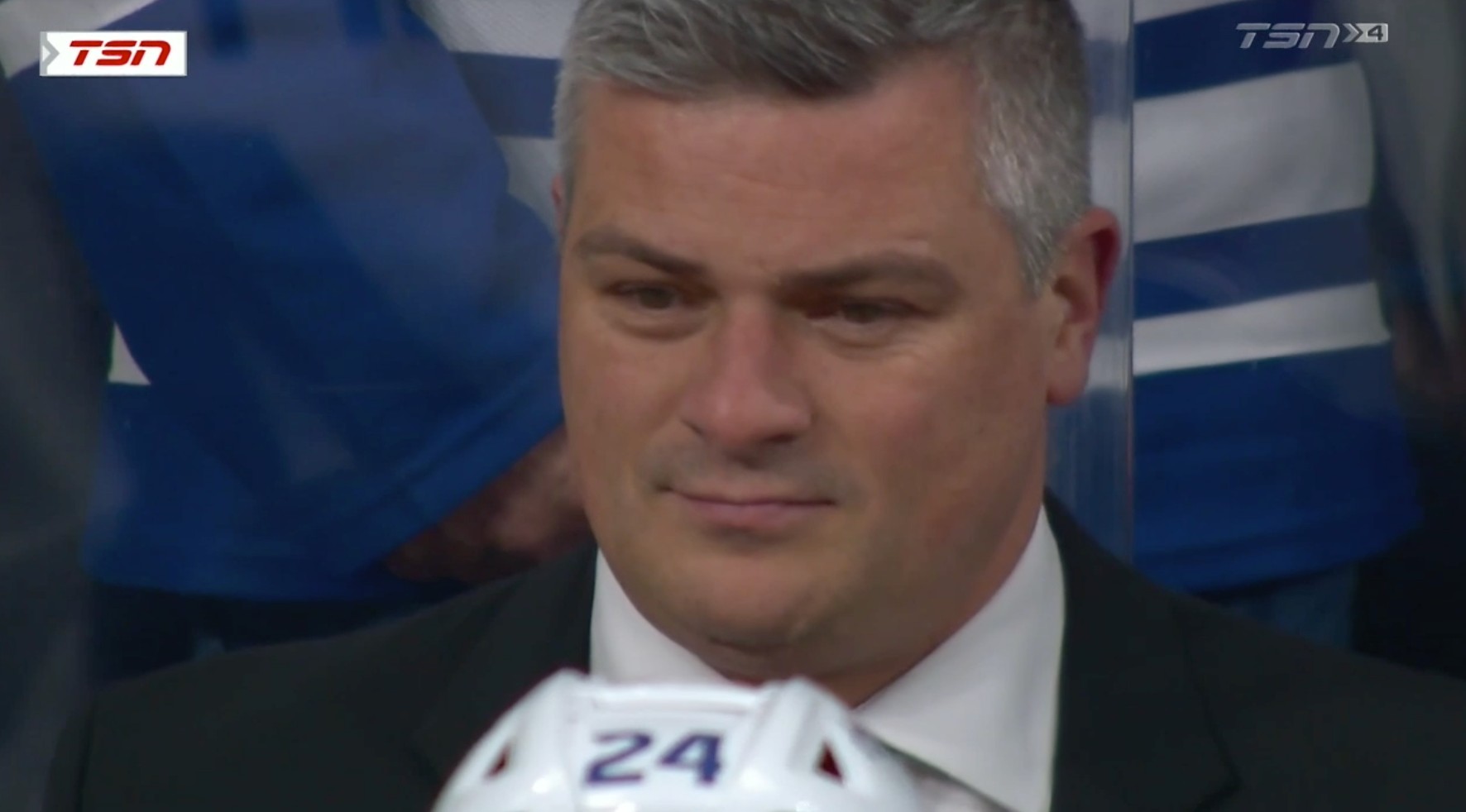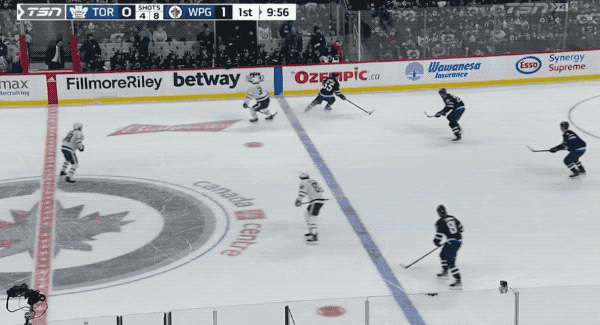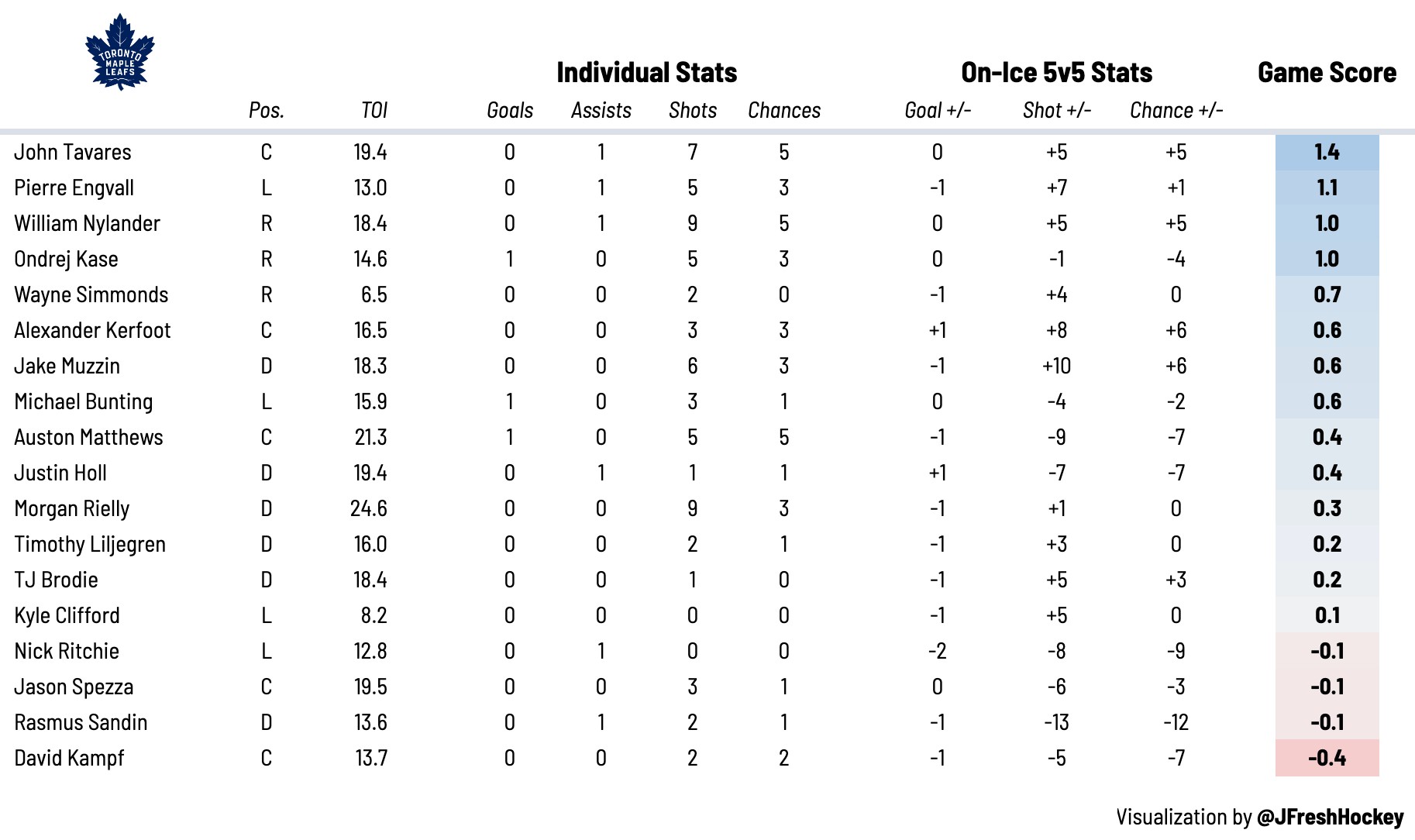
What the hell did we just watch?
This is my reaction — to all of it.
The countless 2v1s Toronto gave up in the second period; some of the worst game management I’ve ever seen from an officiating crew; the feeling of anger, frustration, and eventually, dejection when I think about Rasmus Sandin’s knee injury.
Sunday night was certainly a night in Winnipeg.
Now, let me be clear here: the Jets absolutely deserved to win this game. They significantly outplayed the Leafs, running away with things in the second period when Toronto’s leaky defensive structure resulted in one odd-man rush after another. It’s hard to blame 21-year-old Joseph Woll for giving up goals when his defensemen (and forwards) hang him out to dry like that.
What’s crazy is the Leafs actually got back in this game at one point, and if not for some atrocious penalty killing, might have secured a different result. Regardless, this wasn’t a game they deserved to win.
I have a feeling everyone is pretty fired up after this game, so let’s go through these grades in inverse order. I never do this, but something needs to be said for how poorly this game was handled.
It’s time for some Leafs Report Cards.
-1 Star
The Officiating — I’ve been doing these postgame report cards for a few years now and I never like bringing up referees, especially by name. So often in sports, we’d rather blame the officials for a loss than the team we support and it can lead to some really ugly behaviour.
Again, let’s set the record straight here: Toronto deserved to lose to Winnipeg because of their poor play defensively. I’m not arguing the Leafs lost this game because of officiating.
They did, however, lose a dynamic young talent to a knee injury that might’ve been prevented if the game had been managed better. Everything that followed the Sandin hit was frankly embarrassing, but let’s follow the sequence of events chronologically.
This all started with a dust-up in the corner that could’ve been easily resolved with a minor penalty to Pierre-Luc Dubois. Somehow, Auston Matthews also picked up a minor penalty in that exchange, which even the biggest Bruins homer on Hockey Twitter can admit was an egregious error.
I know I'm the anti-Leafs guy but how the HELL does Matthews get a matching minor here lol pic.twitter.com/jFH8I2ONok
— Pete Blackburn (@PeteBlackburn) December 6, 2021
The NFL protects its stars at all costs, understanding just how valuable quarterbacks are to the league’s long-term success. The NHL “lets the boys play” and it’s a big part of the reason I can’t stand this league despite hockey being my favourite sport. Watching Connor McDavid draw zero penalties in his last two playoff rounds sums up this point pretty well.
Right after the off-setting minors are assessed, this happens.
Rasmus Sandin is down.
Goes knee-on-knee with Neal Pionk pic.twitter.com/Nh1wVXSb9Y
— Omar (@TicTacTOmar) December 6, 2021
Are the two events related? Maybe not. Maybe Sandin gets kneed regardless of what happened beforehand. But this is where the game got out of hand. If you call a five-minute major for kneeing and give Neal Pionk a game misconduct, we probably don’t have to suffer through a third period of attempted cheap shots and fights to settle the score.
No penalty was called on the play, which is just mind-boggling considering Sandin literally had the puck right before he got kneed.
Naturally, the Leafs wanted retribution right afterward. Instead of letting two heavyweights fight after the next faceoff, all four officials scrambled to prevent Wayne Simmonds and Logan Stanley from getting into it. What an interesting time to not “let the boys play” — when there were clearly two willing combatants.
Shortly afterward, Jason Spezza took a run at Neal Pionk that appeared to target the head.
Jason Spezza is an avenger
Goes right for Pionk pic.twitter.com/95v2TID9UE
— Omar (@TicTacTOmar) December 6, 2021
Later on, Kyle Clifford dropped the gloves with Brendan Dillon and appeared to do some serious damage to his hand after repeatedly bashing his fist into a plastic helmet. There’s also the Simmonds-Stanley “fight” at the end of the game when Stanley came to Josh Morrissey’s defense, only for the referees to break things up — again — and Stanley to make a WWE gesture to the crowd.
All of this could have been prevented with some basic game management and an application of the NHL rulebook, which is exactly how it felt after watching Game 2 of the Leafs-Bruins series when things got out of hand between Nazem Kadri and Jake Debrusk.
The reason I bring this up? Brad Meier officiated both of those games. If we truly want this league to be better, it means holding everyone accountable. I’d rather watch hockey than whatever the hell that was in the third period.
Auston Matthews: "It wasn't really hockey in that third period. I mean, it was just a bit of a gong show. I don't really know how else to put it." The young man is absolutely right.
— Ken Campbell (@Ken_Campbell27) December 6, 2021
2 Stars
The Sandin-Holl Pair — I have no clue how to make the transition to actually evaluating hockey players’ performance now, but here goes nothing. Injury aside, this was a rough game for Rasmus Sandin. I didn’t like the way he was defending the rush, often giving up too much space to his man in transition rather than gapping up earlier in the neutral zone.
He also got brushed off by Andrew Copp, who boxed him out en route to scoring a breakaway goal for Winnipeg. At 5v5, Sandin was on the ice for three of Toronto’s scoring chances for and 15 against, which is just a terrible differential of -12.
His partner didn’t play much better. Justin Holl got caught pinching a few times in the second, letting his man get behind him for multiple 2v1s against. Holl also struggled to make quick plays up the ice with the puck, often waiting so long before making a decision that Winnipeg was able to get all five players behind the puck on defense.
If he’s not moving the puck well and not defending the rush at a high level, you have to ask exactly what Holl is doing at 5v5 to provide value for Toronto this season.
TJ Brodie (RD, #78) — It’s not often a defenseman costs his team a game with his penalty killing, but you could make a good case for it with Brodie. Here’s a quick breakdown of his positioning on the three PK goals against when he was on the ice.
- Late to pick up Dubois in front of the net
- Fails to prevent the pass from below the goal line out to Kyle Connor for the one-timer
- Brodie and Kerfoot let Scheifele get behind them off the entry for a breakaway goal
What’s frustrating is I thought Brodie actually looked really steady at 5v5, defending the rush well, retrieving loose pucks, and starting the breakout efficiently. When you’re directly responsible for so many goals against at 4v5, though, it negates a lot of the good you did at 5v5.
Toronto actually had a chance to get back in the game after the Sandin hit, but after Brodie let Scheifele get past him for the breakaway goal to make it 6-3 in the third period, the game was essentially over.
The Ritchie-Kampf Duo — Their linemate, Ondrej Kase, actually did a great job of driving things for the third line, which is why I wanted to group these two together. When you take away Kase’s contributions, it’s hard to find many positives for the third line. The Leafs got drastically outshot and out-chanced when they were on the ice, which speaks to their struggles making plays up the ice with the puck and completing passes in the offensive zone to maintain possession.
It’s worth noting that David Kampf did have a few good moments, breaking up a rush chance on the PK, drawing a trip in the defensive zone at 5v5, and even getting behind the defense for a 2v1 with Kyle Clifford. Unfortunately, he was also the reason Toronto gave up a goal on a 2v1 against, firing a shot into a shin pad when he was covering for a pinching defenseman as F3 at the blueline.
The good news is that Nick Ritchie didn’t have any moments as bad as that. The bad news is that he finished the game with zero shot attempts. As snakebitten as Ritchie is, he’ll need to generate actual scoring chances towards the net if his puck luck is going to turn around.
The Tough Guys — It’s good that Kyle Clifford and Wayne Simmonds mucked it up in response to Sandin going down with an injury; the refs failed to do their job, the Leafs needed a response, and that’s their responsibility to step up in those moments.
It’s also their job to play hockey between the whistles, and I didn’t think they accomplished very much at 5v5. Clifford barely touched the puck all game, while Simmonds finished the game with zero chances from the slot. I’d have liked to have seen a bit more “productive toughness” from these two, which is something we’ve seen from Simmonds quite often this year, just not on Sunday night.
Jason Spezza (RW, #19) — Again, part of me wants to bump him up a few stars for at least showing that he cared by going after Pionk the first chance he got. As dangerous as it was, it reminded me of the fight he started in Game 4 against Columbus. He’s a skilled player who you expect to make an impact in the offensive zone and on the power play, so when he’s the one dishing out the most memorable moment of physicality in the game, it’s something that’s going to stick with guys.
At the same time, I’m trying my best here to objectively evaluate player performance and Spezza wasn’t able to create much offense alongside Matthews on the top line. He also struggled to gain the zone and set up in formation on PP1, which is weird because that’s usually a major strength of Spezza’s.
I’ll commend him for his give-a-sh*t meter being off the charts in the third period, but he had an off night with the puck on his stick.
3 Stars
William Nylander (RW, #88) — If not for a shift that Nylander took off earlier in the game, which resulted in a 3v1 rush against, I probably would’ve had him up with Tavares in the four-star club. When Nylander was moving his feet, he was dangerous offensively, using his speed to gain the zone with possession and make a play off the rush.
He led the team in shot attempts and tied for the team-lead in slot chances. It was another strong performance from Nylander in what’s clearly been a career year for him, but there were moments of inconsistency with his effort level that you’d like to see sorted out.
Alex Kerfoot (LW, #15) — The Kerfoot-Tavares-Nylander trio was by far Toronto’s best line on Sunday night, although it was mostly Tavares driving the bus. As we mentioned earlier, Kerfoot and Brodie both got beat behind by Scheifele on the PK for the back-breaking sixth goal against. He did make a few nice passes at 5v5 to help get the puck going in the right direction, but I still can’t get that PK breakaway that he allowed out of my head.
Timothy Liljegren (RD, #37) — This was a showcase game for Liljegren alongside Muzzin in Toronto’s top four and I thought he handled the assignment quite well. He didn’t blow anyone away with his play, but he was solid when defending the rush and moved the puck up the ice quite well.
There were a few times where it looked like Liljegren was trying to do a bit too much with the puck on the breakout, going for a fancy play instead of making the simple pass to an open teammate. Then again, he also found Matthews up the ice with a wicked stretch pass, so maybe you need to let the chef cook sometimes.
If nothing else, I’d say he’s earned an extended look with Muzzin in this role to see if it’s a viable option for Toronto this season.
Ondrej Kase (RW, #25) — His linemates didn’t give him much help, but when has that ever stopped Kase from kamikazee-ing his way into the offensive zone with speed? His goal from below the goal line is about as lucky as they come (0.01 xG), but he was able to make plays off of the rush, using his speed to get up the ice and into the offensive zone where he could get a good shot off.
Pierre Engvall (LW, #47) — He definitely meant to pass the puck to Ritchie — not Bunting on his power play assist from behind the net — but it was still a nice play. Ironically, Engvall was late to cover Connor on an identical play when penalty killing, with Connor blasting a one-timer past Woll off a pass from below the goal line.
As always, Engvall was using his speed to transport the puck from DZ to OZ, and as always, he had a bit of tunnel vision and took some hard wristers from distance. Part of me wants to think there’s a better play he can make in these situations, but the other part of me is terrified of Engvall trying to out-think a defense and make the right pass.
Morgan Rielly (LD, #44) — Speaking of this shoot vs. pass conundrum, I wanted to point out a bad habit in Rielly’s game from his early days that has all but gone away. Outside of the 2018-19 season, Rielly has always been a below-average finisher at the NHL level, yet he used to take these outside shots off the rush that goalies would easily glove down for a whistle.
I used to yell at the TV every time it happened because I knew he had the wheels to keep skating and wait for a better play to develop. It’s since become my favourite part of Rielly’s game, watching him activate into the play, skate down the wing and wait for the passing lane to open up to the slot.
That patience has made him one of the best east-west passers in the NHL among defenseman and provides big-time value for a team whose calling card is generating high-quality looks from the slot. He completed a few of those passes again on Sunday night, which is what you pay him to do.
Joseph Woll (G, #60) — NHL goalies obviously aren’t supposed to allow six goals against, but if we had access to the data on odd-man rushes and pre-shot movement, what do we think Winnipeg’s expected goals in this game would have been? Four, maybe five goals?
My point is that I don’t think Woll played particularly poorly in this game. For every goal you wish he had back, he made another spectacular save on a breakaway or 2v1. Other than Ben Scrivens’ one magical night, goaltenders just don’t bail you out like that when you give up as many high-quality scoring opportunities off the rush as Toronto did in that second period.
We should probably point out that Woll appeared to pull something in his left leg after stretching out on a diving save across his crease. Oh yeah, he also got kneed in the head after coming way out of his crease to play the puck.
This was such a bizarre game.
4 Stars
John Tavares (C, #91) — It’s so funny watching him slowly and methodically stick-handle his way through a defense. Sometimes he’ll even deke out the same guy twice, since his lack of foot speed prevents him from really “burning” anyone off the rush. Those hands helped Tavares and Nylander generate a ton of offense together at 5v5, including the following chance on a breakaway.
I wanted to show this clip, a) so we can at least be balanced in our review of Nylander’s 200-foot play, and b) because it helps show off those nifty mitts of Tavares we were just discussing.
Another point I wanted to bring up was just how hard Tavares was working to get the puck back. He’s obviously not the fastest skater on the team, but he was putting in some hard strides on the backcheck to stay with his man and disrupt the rush with an active stick, forcing turnovers and helping his team regain possession.
He brings that level of energy every night on the backcheck and in the dirty areas of the ice, which is what you want to see from the captain of the team: leading by example.
Michael Bunting (LW, #58) — I have to give the man credit: he’s always ready for a quick one-timer when the pucks lands on his stick in the slot. That’s how he scored his goal tonight on the power play, thanks to Engvall’s (accidental) pass from behind the net.
I thought Bunting did an alright job making plays off the rush alongside Matthews, although it would certainly help having Mitch Marner there to alleviate some of the playmaking burden.
The penalty that Bunting drew on Nate Schmidt was hilarious, skating directly into him and then grabbing Schmidt, who somehow ended up with the penalty. Bunting followed that up with a dumb penalty in front, forcing the opposing defenseman’s helmet off. Later on, Bunting went down and audibly swore at the ref for not calling a penalty. Knowing how NHL officiating works, he’s going to have to walk the line carefully if he wants to avoid the Nazem Kadri treatment in the near future.
Jake Muzzin (LD, #8) — Even though he got beat behind for a breakaway late in one of his shifts, I thought this was one of Muzzin’s strongest games of the season. He was making plays offensively when he got up in the play, using his heavy shot on one-timers after sneaking in towards the top of the circle. Muzzin also made a few great cross-ice passes to open forwards leading to clean entries.
5 Stars
Auston Matthews (C, #34) — His goal where he beat Hellebuyck clean was disgusting, but it’s also something we’ve come to expect from Matthews. He can snipe an all-world goalie from the dots — this is nothing new. What impressed me more about his play in this game was his playmaking, finding a way to zip passes cross-ice to open teammates in dangerous spots.
One final side-note: I loved this variation to Toronto’s 5v3 approach.
This is something I’ve been dying to see NHL teams try more often. It’s a page right out of Ryan Stimson’s book, setting up below the goal line with two of your best passers and trying to dish a pass out front for a one-timer to your best shooter. The research shows that these types of passes yield a much higher shooting percentage — and my guess is the Leafs’ analytics department is well aware of this.
It’s easier to get open when your opponents all have their back turned. It’s also easier to beat a goaltender when they’re stuck on their goal line; just ask Kyle Connor.
Heat Map
Here’s a quick look at where each team’s shots were coming from at even strength, courtesy of Natural Stat Trick.
The Leafs got outplayed in this game at 5v5, only controlling 46 percent of the shots and 44 percent of the scoring chances. This can’t be said enough; they didn’t deserve to win on Sunday night.
Game Score
Game score is a metric developed by The Athletic’s Dom Luszczyszyn to measure single-game performance. You can read more about it here.
Tweets of the Night
The NHL sending out a memo saying “don’t criticize the officials” is such nonsense when you consider the officiating display. You don’t want to be criticized? Do a better job.
— Rachel Doerrie (@racheldoerrie) December 5, 2021
Hold your employees accountable, NHL.
The Leafs have some of the best bargain contracts in the NHL.
Campbell @ $1.65M
Bunting @ $950k
Kase @ $1.25M
Spezza @ $750kAll four are key contributors. Wayne Simmonds ($900k) is off to a hot start as well.
— Kevin Papetti (@KPapetti) December 6, 2021
Fun fact: Bunting, Kase, and Simmonds all rank in the top 10 of individual expected goals per 60 this year, which indicates they’re getting lots of chances from close to the net.
Love to see this Leafs team stick up for one another.
Bigger than anything that's gonna happen on the scoresheet tonight.
— JD Bunkis (@JDBunkis) December 6, 2021
If nothing else, this is the one positive you can take out of Sunday night’s game. For the first time in a long time, Toronto looked like a team that didn’t want to sit around and get punched in the mouth. I have a lot of respect for that.





































![New Leaf Anthony Stolarz on the opportunity in Toronto: “In Florida, I knew my role as a backup… Now, [Joseph Woll] and I are competing for starts… As a goalie, that’s all you can ask for” Anthony Stolarz, Stanley Cup win, now Maple Leaf](https://mapleleafshotstove.com/wp-content/uploads/2024/07/anthony-stolarz-sc-100x70.jpg)
